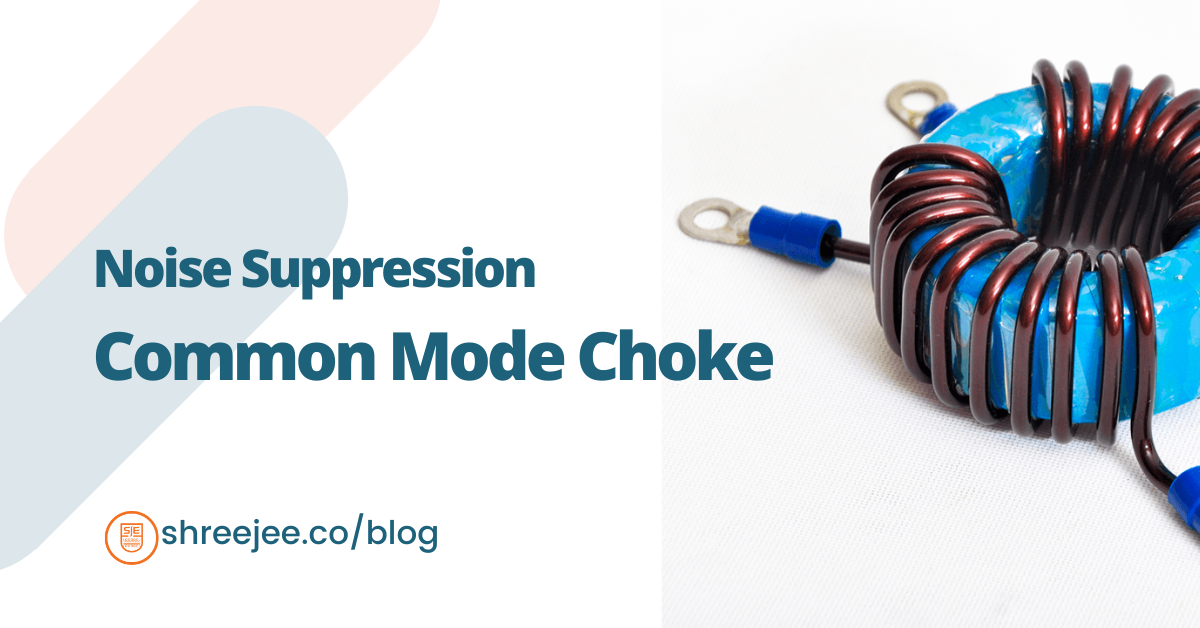Common Mode Chokes (CMCs) are not just critical but indispensable components in electrical engineering. They play a pivotal role in mitigating electromagnetic interference (EMI) and ensuring signal integrity in power supply and communication systems.
What is a Common Mode Choke?
A Common Mode Choke (CMC) is an inductor that blocks high-frequency noise signals that affect both wires. It allows normal signals to pass through. This functionality is pivotal in reducing EMI in power and data lines. Typically, engineers use CMCs in switching power supplies, signal lines, and data transmission cables.
Types of Common Mode Chokes
Common mode chokes come in various shapes and configurations to cater to different applications:
- Toroidal CMCs: These are donut-shaped and provide efficient magnetic coupling.
- Rod Core CMCs: Cylindrical in shape, often used in compact designs.
- Planar CMCs: Flat and compact, suitable for surface mount technology (SMT).
- Split Core CMCs: Designed for easy installation around existing cables.
The choice of core material (ferrite, nanocrystalline, amorphous) and winding configuration (bifilar, multifilar) directly impacts the performance of the CMC in terms of inductance, frequency response, and saturation characteristics.
Selection Criteria for Power Supply Applications
Selecting a CMC for power supply applications involves several critical factors:
- Impedance: The impedance at the target noise frequency should be sufficiently high to attenuate the noise effectively.
- Current Rating: The CMC must handle the maximum operating current without saturating.
- Temperature Stability: The core material should maintain performance over the operating temperature range.
- Size and Form Factor: The physical dimensions should fit within the design constraints of the power supply unit.
Working Principle of Common Mode Chokes
CMCs work by creating opposing magnetic fields in their windings when common-mode currents flow through them. These opposing fields cancel out the common-mode noise. The fields do not cancel out for differential-mode currents, allowing these signals to pass with minimal attenuation.
Winding and Core Material
A CMC’s winding technique and core material heavily influence the performance:
- Winding Configuration: Proper winding ensures maximum impedance and minimal leakage inductance. Techniques like bifilar winding enhance performance by reducing parasitic capacitance.
- Commonly used core materials include ferrites, iron powder, and nanocrystalline materials. Each material offers different permeability and saturation characteristics, affecting the choke’s efficiency and size .
Difference Between CMC, Transformer, and Ferrite Bead
- CMC vs. Transformer: CMCs filter noise, while transformers transfer energy between circuits. Transformers have separate primary and secondary windings, whereas CMCs have a single core with windings that share a common path for the magnetic flux.
- CMC vs. Ferrite Bead: Ferrite beads are simpler devices for high-frequency noise suppression on signal lines. They offer less impedance than CMCs and are unsuitable for high-current applications.
Common Mode Noise
Common mode noise arises from external electromagnetic sources or internal circuit imbalances. It can induce unwanted signals in communication lines and degrade system performance. CMCs mitigate this by providing high-impedance paths for common-mode signals, thus attenuating the noise.
Differential Mode in CMC
In differential mode, currents flow in opposite directions through the choke windings, canceling out magnetic fields. This allows differential signals to pass through with minimal loss.
Differential mode signals are the desired signals that carry information between two lines. In a well-designed CMC, differential mode signals pass through unattenuated, while common mode signals are blocked, ensuring clean and efficient signal transmission.
Applications of Common Mode Chokes
CMCs are used in a variety of applications:
- Power Supplies: To filter out EMI and ensure stable power delivery.
- Data Lines: To prevent data corruption and ensure signal integrity.
- Telecom Systems: To reduce noise in communication lines.
- Automotive Electronics: To suppress noise in vehicle electronic systems.
Data Line vs. Power Line CMC
- Data Line CMC: Designed to handle lower currents and higher frequencies, focusing on minimal signal loss and high impedance at operational frequencies.
- Power Line CMC: Built to handle higher currents with larger core sizes and materials that can withstand high power dissipation.
CMT Style Toroidal CMC
CMT (Common Mode Toroidal) style toroids are widely used in CMC designs due to their efficient magnetic coupling, low electromagnetic interference and compact form factor.
They are constructed by wrapping wire around a doughnut-shaped core, which makes them small and reduces energy loss.
The toroid’s shape/geometry reduces leakage inductance. It also helps cancel out common mode noise from the magnetic fields created by the windings.
Their superior magnetic properties and efficiency make them widely used in power supplies and RF applications.
Some Enriched Insights from Technical Research
Leakage Inductance Estimation of Toroidal CMCs
Leakage inductance in toroidal CMCs is a critical parameter that affects the overall performance of the choke. It is influenced by the core material, winding technique, and the physical separation between the windings. To accurately estimate leakage inductance, use advanced simulation models. These models should consider the core shape and magnetic properties of the materials.
Reluctance and Capacitance Analogy
The analogy between reluctance and capacitance provides a useful framework for understanding the magnetic behaviur of CMCs. Just as capacitance in an electrical circuit opposes changes in voltage, reluctance in a magnetic circuit opposes changes in magnetic flux. This analogy helps in designing CMCs with optimal magnetic properties to achieve desired noise attenuation levels.
At Shreejee Electronics, we use advanced design principles and mathematical models in our manufacturing process. This helps us create high-quality common mode chokes for specific applications.
Submit an RFQ today for our CMCs that are optimized for various applications, ensuring high performance and reliability.
